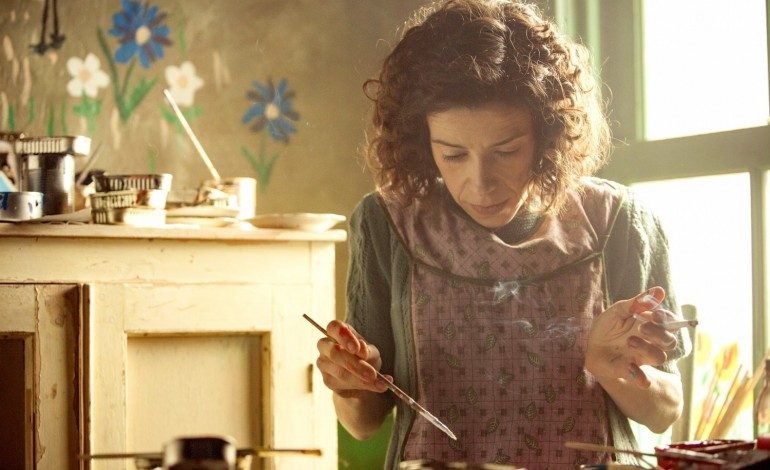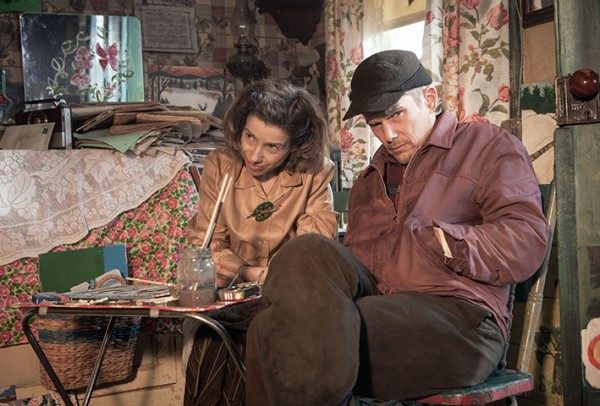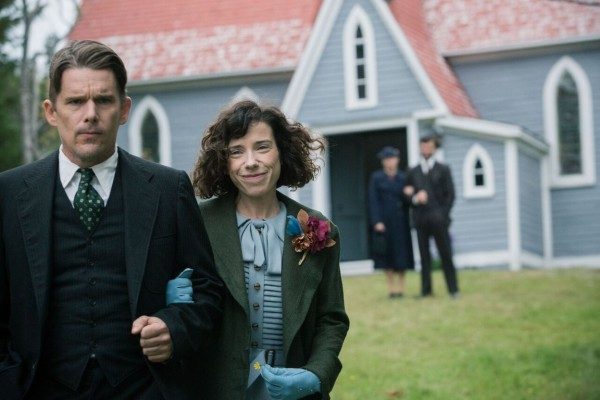

Maudie is a film that comes together quite organically through the collaborative effort of its director, Aisling Walsh, its stars, Sally Hawkins and Ethan Hawke, and its humble yet remarkable story of an artist who shapes her own world through creativity. As a biopic, Maudie is particularly distinct in that it celebrates the talents and fortitude of a human being while not shirking or rose-tinting life’s harsh realities. Depicting the sometimes sweet, yet often contentious relationship of a meek arthritic artist and her gruff, socially inept partner, the film can be difficult to watch at times. However, the film’s dedication to the story’s blemishes brings to light sides of life not often depicted in film — the tarnished moments that strengthen character, relationships, and narrative, and make for a true story centered both in imperfect reality and artistic celebration.
Walsh’s film frames the complicated and harrowing life of Maud Dowley, a Nova Scotia woman who suffers from debilitating arthritis that has made her dependent on her family for most of her childhood and adult life. When her older brother sells their family home and dumps her off onto a reluctant relative, Maud decides to make her own way. Hearing that Everett Lewis, a local fisherman and recluse, is in need of a housekeeper, Maud shows up at his doorstep. After tirelessly breaking down his uncertainty, Maud eventually secures the position and moves into his shack on the outskirts of their small town. Maud and Everett’s relationship, personal and business, follows with rocky results filled by emotional (and occasionally physical) abuse that eventually turns into respect, partnership, and love. The evolution of Maud as an artist unfolds simultaneously, as local success and fame magnifies the couple’s struggles and elevates their smaller human triumphs.
Maud as an artist and Maud as a human are mutually exclusive, and Walsh does a masterful job (with help from a screenplay by Sherry White) in capturing the whole of her experiences and not allowing her fame as an artist dictate or box in the narrative. Painting is initially depicted as Maud’s creative outlet as she faces a world quick to dismiss her for her disabilities. An outlet for her interiority doubles as an outlet for her agency in the world, as Maud retains control and power through her creative abilities and the ownership of her escape.
It is this strength of character that makes an outwardly frail Maud a formidable force next to the towering Everett, who has a conversely frail interior. Although they are equally matched in many respects, Walsh does not make excuses for Everett’s personal failures and blatantly brutal treatment of his physical inferior. For this reason, Everett is not an easy character to like, and their relationship is not an easy one to watch; however, it is nothing if not honest and compelling. Separately and together, Maud and Everett each have led difficult lives (with Everett growing up as an orphan and never experiencing love), and while they are both a bit bruised and broken at first, their mutual character development finds them peace and happiness in small, but significant ways.
Hawkins and Hawke take their mild-mannered, soft-spoken characters and expose their interiority through multifaceted performances. The actors treat their roles like individual paintings, as pictures of life that reveal themselves the more they are given freedom and an audience to do so. Tackling the daunting task of respectfully depicting a woman weighed down by physical circumstance, Hawkins gives presence to Maud, portraying an inner light that guides her journey throughout. Hawkins imbues the character with piercing empathy that is further translated and projected onto Hawke and Everett. Through her, we see the humanity of this man that is his own worst enemy. Hawke, made to look much taller and overpowering in the film through movie magic, strikes a delicate balance between visual mass and virtual weakness. Likely to go down as one of their more unknown roles, Maud and Everett will also be one of their best showings, as both Hawkins and Hawke honestly present two people betrayed by their own physical and emotional dichotomies.
Walsh matches the world of the film to his characters, honing in on the oppressively cloudy atmosphere of the Canadian coast to offset the world of color present in Maud’s art. Although tonally appropriate, the mood is often more bleak than it is hopeful, and at times works to counterproductively smother Maud’s otherwise rich and vibrant story. While displaying a commitment to the harsh realities that Maud and Everett traverse, the visual tone can be suffocating at times, and dampens the film’s lighter moments. In the very least, it parallels the struggles happening within the narrative, but every so slightly allows the darker moods to overshadow the film’s resonating message of fortitude and the celebration of human difference.
Verdict: 3 out of 5
Maudie is a rare and poignant biopic in that it tells a story with both humble beginnings and humble ends, but one that is no less spirited than an athletic comeback or the rise to stardom that are typically covered year to year. Walsh delivers audiences a beautiful rumination on character and human connection bolstered by a life lived simply through talent, creativity, and resilience. Maud and Everett’s intersected story is complicated and not always endearing, but rewardingly provides sincere glimpses into humanity and the unending fight for happiness.



